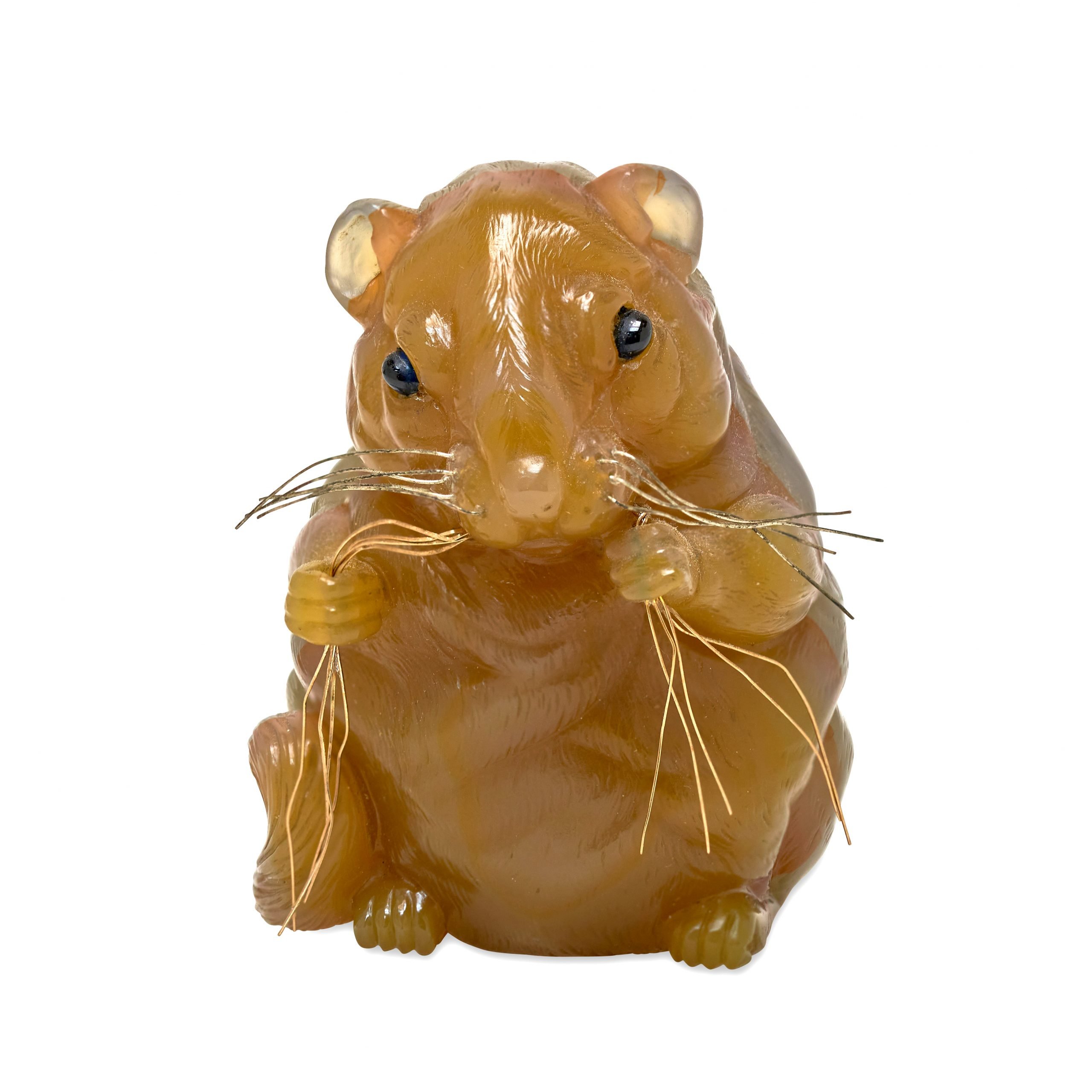
A remarkable collection of tiny carved animals hits the auction block on May 29, proving that Fabergé produced much more than ostentatious eggs. The famed Russian jewelry firm created a whole array of delightful and diminutive creatures measuring only a few centimeters high, with many made specifically for the imperial family.
The London-based Elmwood’s auction house is selling what is deemed to be one of the best collections ever amassed, with provenance leading directly to the Romanovs, as well as British aristocracy and European royalty. The total sale is expected to fetch £1 million ($1.2 million).
Highlights include an extremely rare agate dormouse that was a gift to Immanuel Nobel, father of Alfred, who founded the Nobel Prize. This life-size, honey-colored carving features silver whiskers, eyes of cabochon blue sapphire, and strands of straw made from gold.
A rare bowenite “mystic monkey,” after an ivory netsuke by the master Kaigyokusai Masatsugu (ca. 1900). Photo: © Elmwood’s.
Objects from the Russian imperial family collection include a “mystic monkey” carved from bowenite. It is seen covering its mouth and ears in allusion to the old maxim “see no evil, hear no evil, speak no evil.” There are five of these carvings known to exist, with three residing in London’s Victoria and Albert Museum.
A more naturalistic example comes in the form of an obsidian carrier pigeon, with diamond eyes and gold feet. It is accompanied by a handwritten note in English: “From Olga of Russia Xmas 1907,” which refers to Grand Duchess Olga Alexandrovna of Russia, who gave this as a Christmas gift to her aunt, Princess Thyra of Denmark.
An important imperial jeweled gold mounted bowenite model of a frog, St. Petersburg (ca. 1900). Photo: © Elmwood’s.
However, the most unusual item hailing from the royal household is a comical bowenite frog doing a handstand. It features cabochon ruby eyes and a mouth set with diamonds.
Many of these examples were inspired by the Japanese art of netsuke. Carl Fabergé was known to collect these small, delicately crafted objects that became particularly popular during the Edo period. They were originally designed to secure the cords that hung from the obi sash, worn with traditional kimono. Animals were popular motifs, along with fruits, flowers, and literary figures.
By the late 19th century, these carvings had become a popular collectible in the Western world, as a taste for Japonisme took hold. By 1900, Fabergé had begun modeling animals from hardstone, which showed off the rich variety of materials available in Russia. They proved extremely popular with British clientele once the first London store opened in 1903, and five years later a dedicated stone-cutting department was launched, such was the demand.
An imperial jeweled gold mounted carved obsidian model of a carrier pigeon, St. Petersburg (ca. 1907). Photo: © Elmwood’s.
The craze reached new heights when Queen Alexandra of Denmark (who was married to Britain’s Edward VII) commissioned Fabergé to create bejeweled likenesses of the vast menagerie of animals housed at her Sandringham estate, including, “hens, turkeys, bulls, heifers, horses, and even pigs,” according to Fabergé agent Henry Bainbridge.
The considerable diversity of stone is evident in the pieces sold by Elmwood’s, which include a pale agate used for a seated polar bear; a dark green nephrite depicting a bear; and pink aventurine quartz, with a mottling that makes it ideal for articulating the skin of a pig.
A jeweled aventurine quartz model of a pig, St. Petersburg (ca. 1900). Photo: © Elmwood’s.
The anonymous seller stated: “This collection has been amassed through a pure love of Fabergé’s inimitable animals—for their craftsmanship, quality, and the unique personalities that they convey. While I’m sad to be parting with them, I hope that they will go on to be treasured in the same way as I have loved them over the last eight years.”